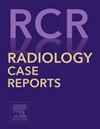Cervical extraosseous Ewing's sarcoma: A case report
Q4 Medicine
引用次数: 0
Abstract
Ewing's sarcoma itself is an uncommon disease. But its occurrence as a primary extraosseous cervical lesion is extremely rare. Considering the rarity of the manifestation of this disease in the form of a soft tissue mass in the neck, and the occurrence with nonspecific initial symptoms, this study introduces a patient whose only initial symptom was neck pain. The patient was a 23-year-old man who had been suffering from neck pain for ten days. Due to neck pain and 1 episode of urinary incontinence, the patient was hospitalized and examined. In the first 6 hours after admission, the patient experienced weakness of the upper limbs. A round lesion was seen in the alignment of the second vertebra with dimensions of 7 × 6 cm. Due to the progression of clinical symptoms, especially in the upper limbs, emergency surgery was planned for the patient. The diagnosis was Ewing's carcinoma. Tumoral cells were seen in diffuse form in small size with large nuclei, hyperchromatic and high N/C with large areas of necrosis. In conclusion, the urgency of surgical intervention in extraosseous Ewing sarcoma cannot be overstated, and it is essential for healthcare providers to remain vigilant in recognizing the signs of this aggressive disease to facilitate timely and effective treatment.
颈椎骨外尤文氏肉瘤1例
尤文氏肉瘤本身是一种罕见的疾病。但作为原发性颈椎骨外病变是极为罕见的。考虑到本病很少以颈部软组织肿块的形式表现,且发生时具有非特异性的初始症状,本研究介绍了一个仅以颈部疼痛为初始症状的患者。病人是一名23岁的男子,颈部疼痛已经十天了。由于颈部疼痛和1次尿失禁,患者住院检查。入院后6小时,患者出现上肢无力。第二椎体排列处可见一圆形病变,尺寸为7 × 6 cm。由于临床症状的进展,特别是上肢,计划对患者进行紧急手术。诊断结果是尤因癌。肿瘤细胞呈弥漫性,体积小,细胞核大,染色深,N/C高,大面积坏死。总之,外科手术治疗骨外尤文氏肉瘤的紧迫性再怎么强调也不为过,医疗保健提供者必须保持警惕,认识到这种侵袭性疾病的迹象,以促进及时有效的治疗。
本文章由计算机程序翻译,如有差异,请以英文原文为准。
求助全文
约1分钟内获得全文
求助全文
来源期刊

Radiology Case Reports
Medicine-Radiology, Nuclear Medicine and Imaging
CiteScore
1.10
自引率
0.00%
发文量
1074
审稿时长
30 days
期刊介绍:
The content of this journal is exclusively case reports that feature diagnostic imaging. Categories in which case reports can be placed include the musculoskeletal system, spine, central nervous system, head and neck, cardiovascular, chest, gastrointestinal, genitourinary, multisystem, pediatric, emergency, women''s imaging, oncologic, normal variants, medical devices, foreign bodies, interventional radiology, nuclear medicine, molecular imaging, ultrasonography, imaging artifacts, forensic, anthropological, and medical-legal. Articles must be well-documented and include a review of the appropriate literature.
 求助内容:
求助内容: 应助结果提醒方式:
应助结果提醒方式:


